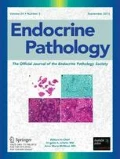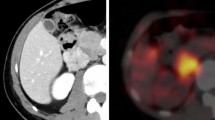Abstract
Pheochromocytomas and paragangliomas, which exclusively produce dopamine, are very rare. Herein, we report for the first time a Japanese case of an exclusively dopamine-producing paraganglioma accompanied by detailed immunohistochemical analyses. A 70-year-old Japanese woman was referred to our hospital for functional examination of her left retroperitoneal mass. Her adrenal functions were normal, except for excessive dopamine secretion. After the tumorectomy, her dopamine level normalized. The histopathological diagnosis of the tumor was paraganglioma; this was confirmed by positive immunostaining of chromogranin A (CgA), tyrosine hydroxylase (TH), dopamine β-hydroxylase (DBH), and succinate dehydrogenase gene subunit B (SDHB). However, the immunostaining of CgA in the tumor cells showed peculiar dot-like staining located corresponding to Golgi complex in the perinuclear area, rather than the diffuse cytoplasmic staining usually observed in epinephrine- or norepinephrine-producing functional pheochromocytomas and paragangliomas. The immunohistochemical results suggested that the tumor cells had sparse neuroendocrine granules in the cytoplasm, resulting in inhibition of catecholamine synthesis from dopamine to norepinephrine in neurosecretory granules. This may be the mechanism responsible for exclusive dopamine secretion in the present case.


Similar content being viewed by others
References
Eisenhofer G, Goldstein DS, Sullivan P, Csako G, Brouwers FM, Lai EW, Adams KT, Pacak K. Biochemical and clinical manifestations of dopamine-producing paragangliomas: utility of plasma methoxytyramine. J Clin Endocrinol Metab 90:2068–2075, 2005.
Kimura N, Takayanagi R, Takizawa N, Itagaki E, Katabami T, Kakoi N, Rakugi H, Ikeda Y, Tanabe A, Nigawara T, Ito S, Kimura I, Naruse M; Phaeochromocytoma Study Group in Japan. Pathological grading for predicting metastasis in phaeochromocytoma and paraganglioma. Endocr Relat Cancer 21:405–414, 2014.
Kimura N, Capella C, DeLellis RA, Epstein JI, Gill A, Kawashima A, Koch C, Komminoth P, Lam A KY, Merino MJ, Mete O, Papathomas TG, Sadow P, Thompson LDR, Tischler AS, Williams MD, Young WF. Extra-adrenal paragangliomas. In: Lloyd RV, Kloppel G, Osamura RY, Rosai J, eds. World Health Organization Classification of Tumours. Pathology and Genetics of Tumours of Endocrine Organs. Lyon, IARC, 2017, in press.
Poirier É, Thauvette D, Hogue JC. Management of exclusively dopamine-secreting abdominal pheochromocytomas. J Am Coll Surg 216:340–346, 2013.
van Gelder T, Verhoeven GT, de Jong P, Oei HY, Krenning EP, Vuzevski VD, van den Meiracker AH. Dopamine-producing paraganglioma not visualized by iodine-123-MIBG scintigraphy. J Nucl Med 36:620–622, 1995.
Smith SL, Slappy AL, Fox TP, Scolapio JS. Pheochromocytoma producing vasoactive intestinal peptide. Mayo Clin Proc 77:97–100, 2002.
Tam V, Ng KF, Fung LM, Wong YY, Chan MH, Lam CW, Tam S, Lam CW. The importance of the interpretation of urine catecholamines is essential for the diagnosis and management of patient with dopamine-secreting paraganglioma. Ann Clin Biochem 42:73–77, 2005.
Yi JW, Oh EM, Lee KE, Choi JY, Koo do H, Kim KJ, Jung KC, Kim SY, Youn YK. An exclusively dopamine secreting paraganglioma in the retroperitoneum: a first clinical case in Korea. J Korean Surg Soc 82:389–393, 2012.
Feldman JM, Blalock JA, Zern RT, Shelburne JD, Gaede JT, Farrell RE, Wells SA Jr Deficiency of dopamine-beta-hydroxylase. A new mechanism for normotensive pheochromocytomas. Am J Clin Pathol 72:175–185, 1979.
Louthan O. Chromogranin a in physiology and oncology. Folia Biol 57:173–181, 2011.
Kimura N, Capella C, De Kriiger RR, Thompson LDR, Lam KY, Komminoth P, Tishler AS, Young Jr WF. Extra-adrenal sympathetic paraganglioma: superior and inferior paraaortic. In: DeLellis RA, Lloyd RV, Heitz PU, Eng C, eds. World Health Organization Classification of Tumours. Pathology and Genetics of Tumours of Endocrine Organs. Lyon, IARC, 2004.
Asa SL. Tumors of the Pituitary Gland. Fascicle 15, 4th Series. The Atlas of Tumor Pathology. Armed Forces Institute of Pathology: Washington DC, 2011.
Kim T, Loh YP. Chromogranin A: a surprising link between granule biogenesis and hypertension. J Clin Invest 115:1711–1713, 2005.
Proye C, Fossati P, Fontaine P, Lefebvre J, Decoulx M, Wemeau JL, Dewailly D, Rwamasirabo E, Cecat P. Dopamine-secreting pheochromocytoma: an unrecognized entity? Classification of pheochromocytomas according to their type of secretion. Surgery 100:1154–1162, 1986.
van der Harst E, de Herder WW, de Krijger RR, Bruining HA, Bonjer HJ, Lamberts SW, van den Meiracker AH, Stijnen TH, Boomsma F. The value of plasma markers for the clinical behaviour of phaeochromocytomas. Eur J Endocrinol 147:85–94, 2002.
Eisenhofer G, Tischler AS, de Krijger RR. Diagnostic tests and biomarkers for pheochromocytoma and extra-adrenal paraganglioma: from routine laboratory methods to disease stratification. Endocr Pathol 23:4–14, 2012.
van Nederveen FH, Gaal J, Favier J, Korpershoek E, Oldenburg RA, de Bruyn EM, Sleddens HF, Derkx P, Rivière J, Dannenberg H, Petri BJ, Komminoth P, Pacak K, Hop WC, Pollard PJ, Mannelli M, Bayley JP, Perren A, Niemann S, Verhofstad AA, de Bruïne AP, Maher ER, Tissier F, Méatchi T, Badoual C, Bertherat J, Amar L, Alataki D, Van Marck E, Ferrau F, François J, de Herder WW, Peeters MP, van Linge A, Lenders JW, Gimenez-Roqueplo AP, de Krijger RR, Dinjens WN. An immunohistochemical procedure to detect patients with paraganglioma and phaeochromocytoma with germline SDHB, SDHC, or SDHD gene mutations: a retrospective and prospective analysis. Lancet Oncol 10:764–771, 2009.
Acknowledgments
We thank all members of the Department of Endocrinology and Diabetology of Ome Municipal General Hospital for their administrative and clinical assistance and Dr. Mitsuhide Naruse at the National Hospital Organization Kyoto Medical Center for helpful discussion.
Author information
Authors and Affiliations
Corresponding author
Ethics declarations
Conflict of Interest
None of the authors have any potential conflicts of interest associated with this research. This case was presented at the 72nd Tama Society of Clinical Endocrinology and Metabolism meeting, Japan.
Rights and permissions
About this article
Cite this article
Matsuda, Y., Kimura, N., Yoshimoto, T. et al. Dopamine-Secreting Paraganglioma in the Retroperitoneum. Endocr Pathol 28, 36–40 (2017). https://doi.org/10.1007/s12022-016-9457-0
Published:
Issue Date:
DOI: https://doi.org/10.1007/s12022-016-9457-0




